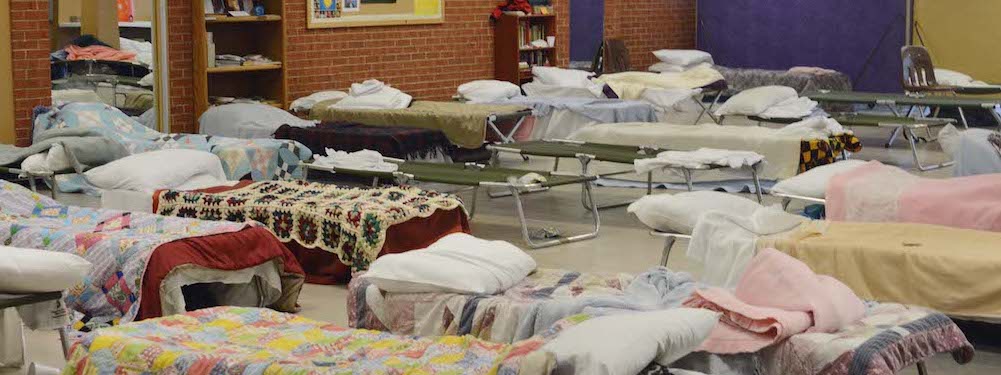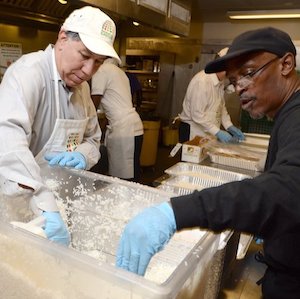 A church provides cots for the homeless during especially cold weather. ©Taylor Pecko-Reid/KOMU8, 2017.
A church provides cots for the homeless during especially cold weather. ©Taylor Pecko-Reid/KOMU8, 2017.
By June Gin
Individuals and families who are homeless are among the most vulnerable members of our society because of their limited resources, social isolation, and the prevalence of health conditions. Disasters amplify these conditions, as the social safety nets that the homeless rely on during non-disaster times can be disrupted and even shut down at a time of surging demand.
The hurricanes, floods, and wildfires of 2017 vividly illustrated the amplified risks that people who are homeless face during catastrophes and the barriers they encounter during community recovery. During the San Diego Hepatitis A outbreak, Hurricane Irma, and the California wildfires, individuals experiencing homelessness were perceived as threats due to social stigma and negative perceptions. They also experienced challenges in communities that didn’t fully incorporate the realities of homelessness into plans for emergency response or disaster mitigation. For instance, homeless individuals might not evacuate or take other life-protective measures because of lack of information and distrust of messengers.

Volunteers and staff prepare food to be served at homeless shelters at D.C. Kitchen. ©Tom Witham/U.S. Department of Agriculture, 2012.
This past year also saw the first rise in the U.S. homeless population in nine years; driven largely by an affordable-housing crisis in West Coast cities such as Los Angeles and San Francisco. In 2017, 554,000 individuals were homeless on a given night in the United States. Disasters make these housing shortages even more dire for individuals who are trying to find homes. Integrating people experiencing homelessness into disaster planning is a challenge for many communities. Homeless service providers are not always well connected to emergency management and disaster relief organizations; local community-based organizations (CBOs) can lack plans that ensure the ability to provide post-disaster services; and healthcare services for people experiencing homelessness may not be readily available. Many of the CBOs that provide essential daily services and help individuals overcome homelessness have not taken preparedness actions, particularly continuity of operations planning to ensure they can continue delivering vital services.
To address these challenges, a new evidence-based toolkit—Disaster Preparedness to Promote Community Resilience: Information and Tools for Homeless Service Providers and Disaster Professionals—offers communities research-driven resources and guidance to ensure that the needs of individuals experiencing homelessness are included in disaster planning, response, and recovery. A federal interagency team of researchers and practitioners developed the toolkit by consulting with more than 50 subject matter experts in emergency management, public health, and homeless services to distill best practices and lessons learned.

The toolkit provides an overview of the challenges that occur during and after disasters and the impact of those challenges on people experiencing homelessness. It provides guidance that will help homeless service providers and emergency managers develop partnerships that address the disaster needs of homeless individuals. It also outlines strategies to avoid disruption of services for homeless-serving CBOs and healthcare providers. The toolkit also includes tips for healthcare settings to ensure that they are adequately staffed with providers experienced in serving people who are homeless.
The toolkit is divided into three sections:
• Creating an Inclusive Emergency Management System
• Guidance for Homeless Service Providers: Planning for Service Continuity
• Guidance for Healthcare Providers
Communities that are engaged in best practices reap the benefits of increased collaboration. San Diego’s 2017 Hepatitis A outbreak prompted public health officials to build stronger ties with homeless outreach organizations to set up handwashing stations that curb disease spread. My colleagues across the country have similar examples to share. For instance, during Hurricane Sandy, Philadelphia’s public health department collaborated with CBOs serving at-risk populations to encourage people living on the street to take shelter.
Similar measures were taken in Florida during cold weather episodes, when formerly homeless veterans residing in transitional housing participated in outreach to those living in homeless encampments. After Hurricane Irma, the Florida American Red Cross chapters built on their strong relationships with homeless organizations to help individuals in shelters find permanent housing. Not only did this relationship prevent hurricane-affected individuals from becoming homeless, it also enabled the Red Cross chapters to close the disaster shelters more quickly. As a living document, the toolkit uses lessons like these to exemplify partnerships that make communities more resilient.
The toolkit is a joint product of the U.S. Department of Veterans Affairs Veterans Emergency Management Evaluation Center (VEMEC), the U.S. Department of Health and Human Services Office of the Assistant Secretary for Preparedness and Response, and the U.S. Department of Housing and Urban Development Special Needs Assistance Programs Office. For more information, please contact June Gin at june.gin@va.gov.
June Gin is a research health scientist at the Veterans Emergency Management Evaluation Center. She works to create evidence-based tools and resources to improve disaster preparedness in community-based organizations serving homeless veterans and leads projects to strengthen the preparedness of safety net organizations serving individuals experiencing homelessness.